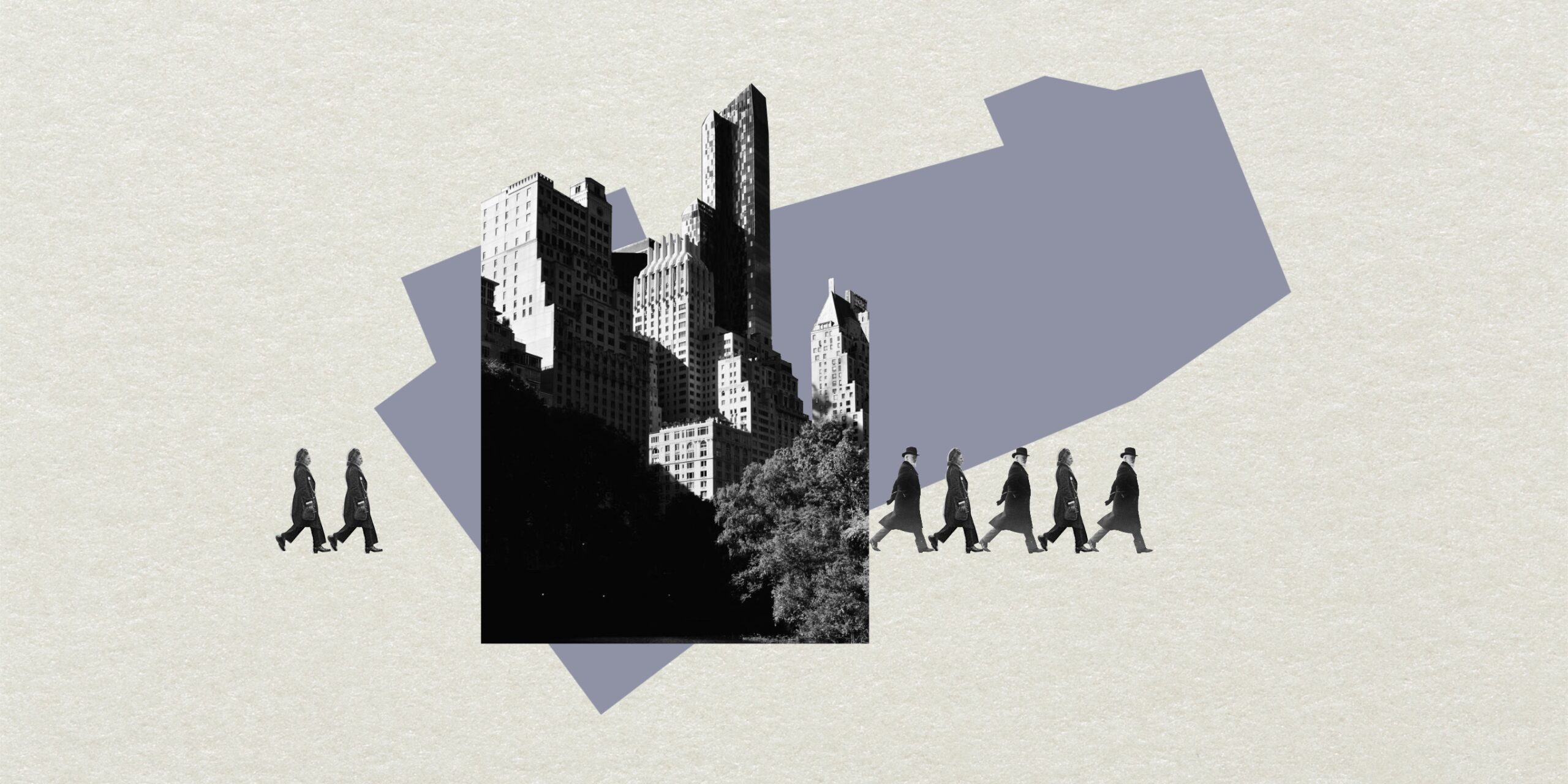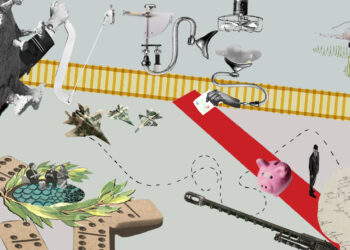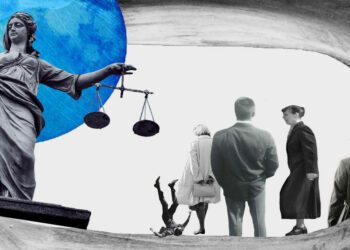
Illustration by Armine Shahbazyan.
Throughout the 20th century, various thinkers have addressed the role of urban spaces in political life, viewing them as the main arena for labor and political organization. Spaces, together with time, transformation and causality, were recognized as interlinked factors that affect historically significant political events and facilitate our understanding of them.
Urban planning can reveal much about a political regime and the goals of a given government in a country, since the design of public spaces and residential areas in cities in particular sends a number of direct and indirect messages about the state of liberties and rights in a society. In autocratic regimes, public spaces are often merely a symbol of power, not designed for multiple purposes, or to serve the needs of society. However, the connection between politics and urban spaces is not solely about how the former affects the physical appearance and social functions of the latter, but also how the “urban” can affect politics beyond its physical functions.
We have witnessed a lot of discussions around urban areas, especially public spaces, when it comes to discussing revolutionary events in the beginning of the 21st century. For instance, during the Arab Spring in the Middle East or the EuroMaidan revolution in Ukraine, the central squares in Cairo, Tunis and Kyiv were not only the symbols of those movements, but also the main areas where clashes between government forces and protesters took place. However, what if the “urban” continues to influence politics even after the revolutions? And what if the “urban” and the “political” can even collide and reshape one another? Taking the recent events surrounding Yerevan City Hall and now-former-Mayor Hayk Marutyan, the complicated relations between the “urban” and the “political” in post-revolutionary contexts come to light.
The 2018 “Velvet Revolution” marked a significant milestone in the path of independent Armenia’s democratic transition. Serzh Sargsyan, President of Armenia for 10 years, resigned, and Nikol Pashinyan, a member of the opposition Way Out alliance, became the Prime Minister. As a result of the constitutional reform that converted Armenia to a parliamentary republic, Sargsyan had been voted in as Prime Minister by the Parliament his Republican Party of Armenia dominated. The prospect of him effectively doing away with term limits in this way was the main trigger of the revolution, but the movement was also a protest against the existing social injustice and corruption in the country. The peaceful transition of power was welcomed by international institutions. The revolution had managed to mobilize people throughout the entire country, with Yerevan being the epicenter. The movement adopted a mobile and dynamic approach, calling on people to organize themselves in their respective neighborhoods to block streets and traffic, and in this way paralyzing the city. Since it was not possible to block all the streets in Yerevan simultaneously, protesters would block one street, then after the police made them move, they would move to another street, only to return to the first street later on. Every morning, Pashinyan would send a message indicating which streets should be blocked that day. There was an unofficial competition to see who would come up with the most creative way of blocking the streets among the different districts in the city. In many parts of Yerevan, protesters would play volleyball, dance traditional dances, and set up barbecues. The protesters would gather at Republic Square every evening to show their support and listen to Pashinyan’s plans. The revolution took place in the entire city, not only on some specific squares or central areas. In this way, space became a facilitator of the entire movement. The paralysis of movement throughout the capital was a key factor in the revolution’s success.
However, this was not the first time Armenians had organized a massive protest/movement in the center of Yerevan. Representatives of civil society organizations and civic activists who were at the core of the “Velvet Revolution” have been part of various social movements, including urban ones such as the “Mashtots Park” movement in 2012, “We Pay 100 Drams” (against the increase of public transportation fares in Yerevan), “I’m Against” (proposed pension reforms), “Save the Afrikyan Building”, “Electric Yerevan” (against the increase in electricity prices). The “Mashtots Park” movement in 2012, which saved a park in the city center from being turned into a shopping area with boutiques, was a strong starting point for the forging and activation of Armenian civil society. The activists of the “Mashtots Park” movement later engaged in other massive movements taking place in Yerevan. “We Pay 100 Dram” is especially notable since many people from the core organizational team would later go on to be elected to the National Assembly and Yerevan City Council, or assumed government positions following the 2018 “Velvet Revolution”. Former Mayor Hayk Marutyan actively took part in the movement, calling on car owners to offer a ride to people during the demonstrations. It is believed that his participation contributed to the popularity of that movement, especially among young people, and managed to attract other celebrities as well. Some even argued that urban movements served as rehearsal platforms for the “Velvet Revolution”.
The first platform where the new balance of powers was tested after the revolution was the urban one. In the Yerevan City Council election of September 23, 2018, Pashinyan’s My Step Alliance won with 81% of the vote. This resulted in Hayk Marutyan, an ally of Pashinyan and known to the public as a producer, actor and urban activist, becoming the Mayor of Yerevan. Together with him, many other urban activists were also elected to the Yerevan City Council. This was followed by a snap parliamentary election that took place on December 9, 2018, where Nikol Pashinyan’s My Step Alliance won 70%, and the “Velvet Revolution” came full circle, with many civic activists becoming Members of Parliament as part of the My Step Alliance.
With the transfer of so many activists, representatives of NGOs and civic initiatives to the state sector in Armenia, it does not come as a surprise that the new officials initiated reforms and projects aimed at bringing about changes in various spheres. Here again, first attempts were directed toward urban planning and development, with a specific focus on the reclamation of public spaces and restoring green areas. The new authorities of Yerevan’s City Council started the process of reclaiming public spaces in 2019 with the demolition of a number of cafes around the Opera House. This move by the municipality precipitated protests by the cafe owners and their employees; the city administration insisted that they were fulfilling a campaign promise. Marutyan also came down hard on illegal construction that had been taking place in the capital and issued orders to dismantle any structure that did not have a valid building permit. Those initiatives were met with harsh reactions from the private sector, which had ties with the previous regime and were unwilling to comply with the new rules.
The 2020 Artsakh War, which resulted in Armenia’s defeat and the deployment of Russian peacekeepers, shocked the Armenian political system with snap parliamentary elections scheduled for June 20, 2021. It initiated a wave of resignations from the My Step Alliance, from Yerevan City Council, the National Assembly and the executive branch. Many of the Yerevan City Council members that resigned from the alliance and/or the city council itself were former urban activists. This was just the beginning of the crisis evolving around the Yerevan Municipality.
Starting in spring 2021, when the campaign for the June 20 election was officially launched, there had been rumours that then-Mayor Marutyan did not support Pashinyan’s Civil Contract Party. The rumors were confirmed in the fall of 2021. City Council members from the My Step Alliance started making claims that Marutyan had lost contact with the Caucus a long time ago, making his future as mayor impossible. Several councillors that supported Marutyan started talking to the media and using social media platforms to tell people about the reforms Marutyan had managed to complete during his term as Mayor starting in 2018, especially in public transportation and waste management. On Dec, 22, 2021, Marutyan was dismissed as Mayor of Yerevan after the City Council passed a vote of no-confidence against him. In his final speech, he presented his reforms in the capital city, and noted how often his efforts were not welcomed by the My Step Caucus, how Pashinyan and his team had betrayed the “spirit” of the revolution. Those were the main reasons for him to leave the party in the fall of 2020, a move he did not want to make public because of the delicate situation the country was in. He announced that his dismissal is illegal, illogical and against the interests of the city.
After the vote of no-confidence, another wave of resignations at City Council rippled through. Among those who resigned were former activists and those who have a long history of working in civil society. The remaining City Council members are presumably loyal to Pashinyan first. Gradually, the urban component of the revolution—people who had been involved in various movements and initiatives targeting urban issues—left the “revolutionary team”. They were among the supporters of the revolution in 2018, and it was the first time when such a large contingent of civic activists appeared on City Council. What does this mean for the city though? Will those who resigned go back to civil society, be the watchdog for the municipality’s actions and cooperate with the City Council to promote adequate urban policy-making? Or does this mean that we are back to the pre-revolutionary period, when the City Council did not have any connection to their voters’ needs and interests? The “urban” and the “political” are connected, sometimes collaborating and sometimes colliding, especially when political affiliations are in play. Time will show if the withdrawal of the “urban” marks the end of the revolution, or if it will be the component that will revive the spirit of the revolution.
New on EVN Report
Russia’s Cruel Dilemma
Torn between neo-imperial ambition and the limits of its own system, Russia lives under the dual risk of American sanctions and Chinese encroachment.
Read more2021: The Post-War Year
2021 was a difficult year for the Armenian nation as it continued to confront external threats, Azerbaijani incursions into its sovereign territory and an unclear future for both Armenia and Artsakh. Here we present a brief overview of the main events from the past year.
Read moreA More Pragmatic and Goal-Oriented EU?
Through a number of developing steps, the EU wants to open a space for a greater role in the South Caucasus and particularly in managing the Nagorno-Karabakh conflict, which is now dominated by Russia and Turkey, writes Anna Barseghyan.
Read moreProtecting Armenians’ Human Rights Through the European Court
Human Rights Day is observed on December 10 each year to celebrate the adoption of the Universal Declaration of Human Rights. There have been several cases in which the European Court of Human Rights has found Armenia violated the protected rights of citizens.
Read moreHealing War Trauma With Art Therapy
A new program is implementing art therapy classes to help children in one of Armenia’s poorest regions cope with the trauma of war and process the barrage of negative news and feelings.
Read more





